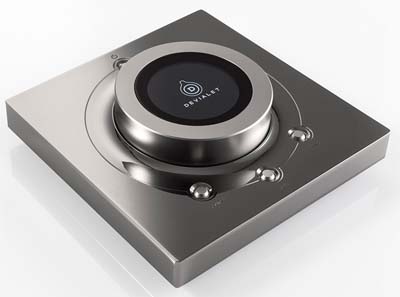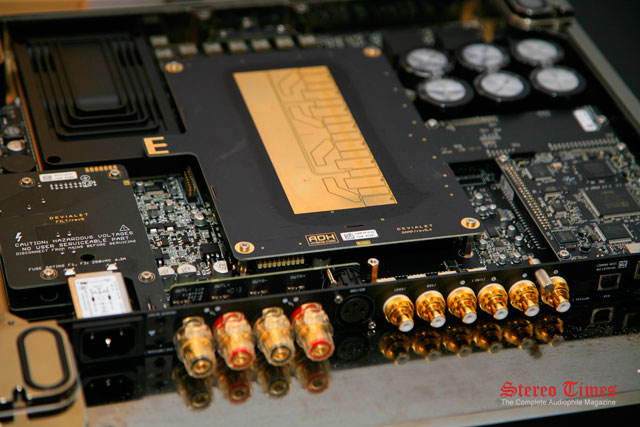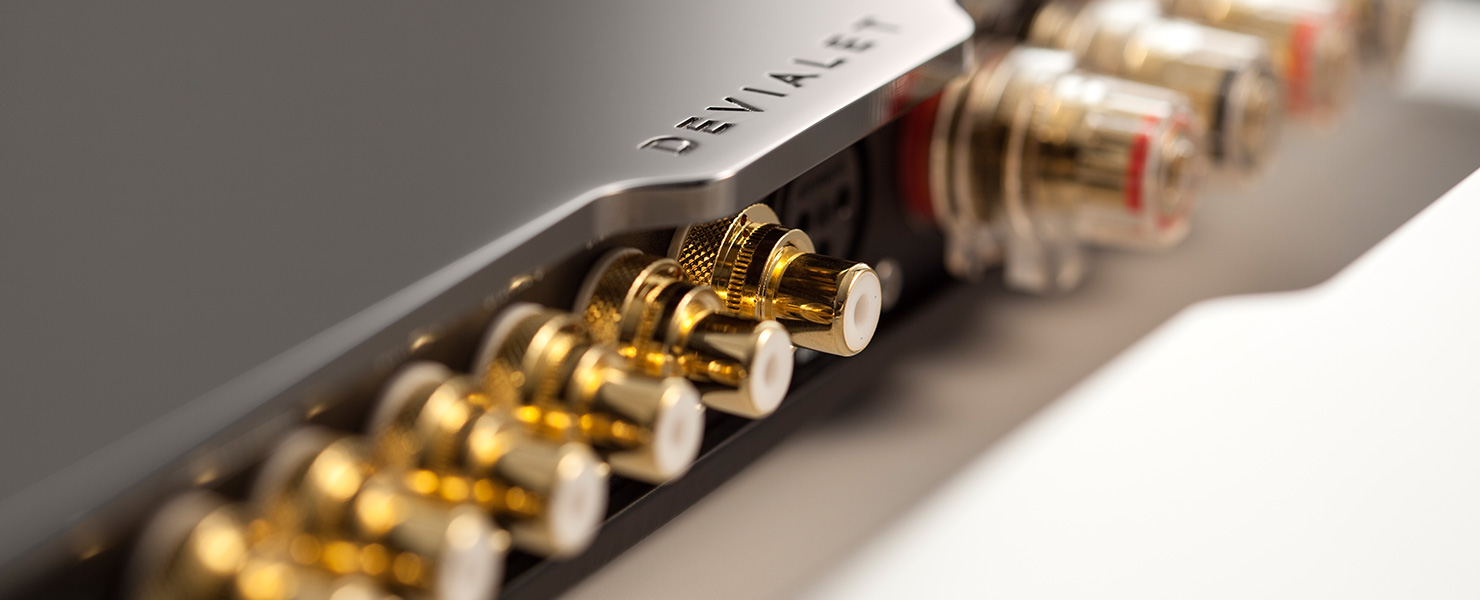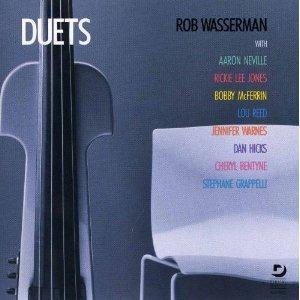Devialet 200

 Being of diminutive stature I had known that “Small is Beautiful” long before I read the seminal work of the British economist, E.F. Schumacher (Small Is Beautiful: A Study of Economics As If People Mattered) a few years after it was first published in 1973. More recently I have watched in frustration as the hi-end audio manufacturers went “large” while simultaneously complaining that high end-audio was dying. They created larger boxes to the point where many of their customers, aging but affluent Baby Boomers, are no longer able to heft the weight. Or, for that matter, fit the equipment in their downsized residences. This same heavy-testosterone size and weight has alienated almost all of the gender that comprises more than half of the world’s population, makes up a significant percentage of musicians, and is a growing economic force. I now share the feminine gender’s avoidance of heavy equipment.
Being of diminutive stature I had known that “Small is Beautiful” long before I read the seminal work of the British economist, E.F. Schumacher (Small Is Beautiful: A Study of Economics As If People Mattered) a few years after it was first published in 1973. More recently I have watched in frustration as the hi-end audio manufacturers went “large” while simultaneously complaining that high end-audio was dying. They created larger boxes to the point where many of their customers, aging but affluent Baby Boomers, are no longer able to heft the weight. Or, for that matter, fit the equipment in their downsized residences. This same heavy-testosterone size and weight has alienated almost all of the gender that comprises more than half of the world’s population, makes up a significant percentage of musicians, and is a growing economic force. I now share the feminine gender’s avoidance of heavy equipment.
I injured myself the last time I moved a heavy piece of audio equipment. I am not alone. At the recent T.H.E. Show in Newport Beach I talked to several other audiophiles of my Baby Boomer vintage who were also feeling the need to limit equipment size and weight. Sadly, my days of “big aluminum” are over. Now my system and I are on permanent diets. Do not mistake my bias for size to in any way diminish my demand for the best performance I can afford. I admit to being a bit of a gear-head but the music always comes first and a slim wallet and space constraints keep me sane with my purchases.
On the other end of the age spectrum, the “iPhone generation” has grown up carrying the world in their pocket or wearing it on their wrist. They covet slick and slim, multi-function devices, and they are willing to pay for perceived quality. They are not impressed by big size or single-purpose and are not intimidated by technology. While the emotional connection to music is as important as ever, I don’t foresee them fawning over much of the equipment that is available to them.
Several blue-chip companies of the 70’s and 80’s (Kodak, Xerox, Polaroid, and IBM) went bankrupt or nearly so because they needed a weatherman to tell them which way the wind blows. They were too slow recognizing the times they are a changing. I acknowledge that some audio equipment companies have done well for decades but just because something works does not mean it works the best. And because something has always worked in the past does not mean it will always work in the future.
Attendance at regional shows is at record high levels. But how many attendees are buying? I have heard anecdotal accounts from several manufacturers that attendees are using the shows for entertainment but not buying. They come to ogle the latest Lamborghini then drive home in 6-year-old Camrys. Do I predict all existing audio manufacturers will fail? No, but I do predict the most successful ones will reinvent themselves.
It pains me to say these things about the industry because some members I consider friends. Others have gained my respect and admiration through their sheer passion, dedication, and courage to take the risks they do. At the same time I can’t agree with the predominant approach they take.
Most designers are using convergent thinking to push the envelope only in the direction it has been going in for decades. That only results in MK2 or Signature versions of existing products yielding incremental improvement at best. To really push the envelope it is necessary to start with a clean-sheet design. Without divergent thinking, true progress is not possible. One of the most successful companies in history, Apple, was not afraid of being disruptive. In fact it was an essential element of their culture as was promoted by their grammatically incorrect, but famous catchphrase, “Think different”.
That is why I would describe the Devialet products as “equipment as if people mattered” or “equipment as if music mattered”. In the case of Devialet, small really is beautiful in both aesthetics and performance and the Devialet engineers truly did “think different”.
Evolution or Revolution?
Because Devialet is a recent entry into the audiophile market they have started with a fresh perspective, unburdened by legacy products and expectations. The Devialet 200 is the most exciting piece of equipment to ever grace my home with the possible exception of my Quad ESL-2805s. I have had the Devialet for enough months and played enough music to know it is not a temporary infatuation. I have only grown fonder. I have to resist the temptation to put my performance summary here. Before I give away the punchline, I need to describe the Devialet 200.
 The first thing that grabs attention is the sleek chassis carved from a solid block of aluminum with a mirror-like black chrome finish. Likewise the remote is also carved from a single, square block of aluminum. It is elegant in its simplicity with only four buttons and a large knob for adjusting volume. One feature that I appreciate is: the Devialet automatically reduces the volume to -40dB whenever a new input is selected. This protects speakers from pilot error. Users can change the setting to something not as severe if they wish. The remote adjusts volume very smoothly in 0.5dB steps.
The first thing that grabs attention is the sleek chassis carved from a solid block of aluminum with a mirror-like black chrome finish. Likewise the remote is also carved from a single, square block of aluminum. It is elegant in its simplicity with only four buttons and a large knob for adjusting volume. One feature that I appreciate is: the Devialet automatically reduces the volume to -40dB whenever a new input is selected. This protects speakers from pilot error. Users can change the setting to something not as severe if they wish. The remote adjusts volume very smoothly in 0.5dB steps.
The remote buttons can also be used to access information such as internal operating temperatures, digital input frequency, balance, tone controls and others. While the radio-controlled remote is a handful it does not need to be handheld. It can conveniently be left on a table but the small display will require removing one’s derriere from the listening chair for some functions. A remote with a display would be the perfect improvement to an already incredible device.
At first blush the many features of the Devialet may seem intimidating but operation is so easy it quickly becomes fun. There are options for the user to configure some inputs to be either analog or digital. The phonograph input accepts both MM and MC cartridges and can be configured to match specific characteristics of the cartridge used (see Specifications).

Configuring inputs is simply a matter of going to the Devialet website and using the “configurator” to establish the desired settings and download the configuration to the supplied 4GB SDHC flash memory card. Then insert the card into the Devialet. The configuration can also be saved to the computer for future use. This is a useful feature if someone needs to change back and forth for different phonograph cartridges or turntables although I suggest multiple SDHC cards to make that switch easier if it is done frequently. Note that there is a 4GB size limit. SDHC cards are also used to update firmware. This useful feature allows updating the unit without cost or downtime.
Likewise the WiFi input must be configured if the user wants to use the proprietary “AIR” streaming feature. But leaving those items aside for the moment, the Devialet demo unit supplied was ready to play right out of the box with default inputs already operational. And what red-blooded audiophile doesn’t want to chuck the instruction manual and start listening to new equipment as soon as possible?
Connecting a Devialet can pose a problem if, like me, you have amassed a pile of unfriendly cables. The slim chassis and low feet leave little room for stiff speaker cables or large power cords. There is a removable cover that can be left off to give extra space but the low shelf clearance makes it difficult to install stiff speaker cables with spade terminations since the plastic-covered binding posts only load from the bottom. The best option is straight-on banana terminations. Locking bananas that are angled (e.g. WBTs) are also problematic. Using footers to raise the Devialet can be helpful in making connections. Another option, if the location permits, is to push the Devialet all the way to the rear of the shelf.
Streaming
AIR is the Devialet proprietary program for music streaming via either WiFi or Ethernet. That makes one less box needed for modern audio systems. I was not able to maintain the WiFi connection. In my home the Devialet would connect and then immediately start searching and reestablishing a connection, despite my desktop in the next room showing 5 bars maximum strength and my iPad sitting on a shelf two feet above the Devialet showing maximum strength from my AT&T U-verse router. Others have reported similar difficulty. Hopefully, when Devialet fixes the WiFi connection issue it will be a simple download for the user to install. On the other hand, the Ethernet performance was impressive even though the first leg (desktop to router) was via WiFi.

Technology
Devialet’s compact size and high quality performance is the result of two major technology developments. First is what Devialet terms their “Magic Wire” DAC. It starts with a Texas Instruments PCM1792 (24bits/192kHz) DAC followed by the Magic Wire, a patented method of converting the TI DAC’s output current into voltage. The second very critical development is what Devialet terms ADH® (analog/digital hybrid). In this unique design, two amplifiers operate in parallel (not series). A Class-A analog amplifier sets the output voltage while digital amplifiers provide most of the current. The resulting hybrid architecture divides the output impedance of the analog amplifier by 100.
Class-A operation makes the Devialet operate quite warm, even hot. However, temperature should not be confused with BTUs. As warm as the Devialet feels to the touch, it does not seem to create heat in the shelf area like my tube amplifier does. I attribute that to the fact that the Devialet chassis design does not dissipate heat very well. Therefore equipment operating temperature gives a false sense of how much heat (BTUs) is produced. Still, the operating temperature of the Devialet is my only serious disappointment. Using the remote buttons in a prescribed manner displays the temperatures of the Class-A amplifier, Class-D amplifier and the power supply. I noted operating temperatures of 500C (1220 F), 480 C (1180F) and 510C (1240 F) respectively after six hours of use at a moderate volume. Nordost Pulsar Points provided 1” of ventilation clearance under the unit. Room temperature was 780 F. The Devialet was painful to touch but I could not feel any heat holding my hand 1” above the unit. Regardless, with the brutal summer temperatures where I live I was hoping for something that ran closer to Class-D temperatures.
SAM®
SAM is the acronym for Speaker Active Matching, a proprietary system to optimize the Devialet to selected speakers. Users report improved bass response and dynamics. At the same time, SAM protects drivers by limiting excursion. Devialet does this by carefully measuring speakers at their facility to determine certain performance parameters including excursion and acceleration.
When applied by the end user, SAM employs real-time DSP correction to enhance speaker performance while providing protection from excess excursion. SAM is not a take it or leave it proposition. Users can choose to use SAM at 100% or reduce the level to whatever pleases them and matches their room and music. SAM is available for over 430 speakers and more are being measured. Unfortunately it is not yet available for the Quad ESL-2805s used for this review. (Quad review here: http://www.stereotimes.com/post/quad-esl-2805)

Performance
I found using the analog outputs from my Laufer Teknik Memory Player 64 into the Devialet quite impressive. However, I did not feel there was anything to be gained by doing a conversion at each end. To keep the system as minimalist as possible I used the AES/EBU digital output from the Memory Player. But using the right digital interconnect proved essential. A JPS Labs Aluminata was the clear winner in my system. Performance with other cables ranged from good to mediocre and lifeless. Some cables provided a fuller-bodied sound but the tradeoffs were loss of resolution, dynamics, and bass control. Unless noted, all my performance comments are based upon digital input using the JPS Labs Aluminata.
The Devialet 200 was nonplussed handling the 4-15ohm swing of the Quad ESL-2805s. Other amplifiers have not fared so well. On the top end, my Sopranino super tweeters (review here: http://www.stereotimes.com/post/enigmaacoustics-electrostatic-super-tweeter) revealed no harshness. Two areas stand out with the Devialet, although I wince at the words stand out because the performance of the Devialet is very even and balanced overall.
One performance characteristic is the dead quiet background. It provides a truly blank canvas to paint audio portraits on, capturing subtle nuance and detail. The other noteworthy area is the bass: dynamic and solid while simultaneously being exceptionally tight and detailed.
Frequently amplifiers reputed to have excellent bass overpower the music, the speakers, and the room. The bass dominates. But that is not the case with Devialet. Here the bass has more impact than I am used to while maintaining its proper balance with the rest of the music. I have heard many speakers with prodigious bass. Usually I wanted to walk or run out of the room. With the Devialet on Quads I wanted to turn it up. The bass was so tight it had more impact than the dull diffuse, but loud bass from many other amplifier/speaker combinations. Bass control was the best I have heard on my system and that is without the benefit of SAM which is not available for my speakers. I hope they are eventually added to the SAM list. (hint, hint)

The Devialet gave me an entirely new experience when I played the tracks “Slow Train” and “Jockey Full of Bourbon” from the Joe Bonamassa CD, An Acoustic Evening at the Vienna Opera House [J*R Adventures PRAR944445]. If you play Joe B. and don’t want to grab your air guitar, something is wrong, but the two tracks referenced are defined by the percussive instruments. Talk about bass slam! I did not know Quads could do that. I watched smiling, as a guest, also a Quad owner, shook his head in amazement when I played the Bonamassa tracks. Simultaneously I was thinking, YES, THAT’S HOW ITS DONE!
Bass using the analog output on my Memory Player into the Devialet suffered from less control. Bass was softer with less impact and tended to linger longer than I felt it should. Overall the digital input provided a more dynamic presentation and sharper focus maintaining more of the “live” feel.
 The quality of the bass is further exemplified on the track “Ballad of the Runaway Horse” featuring Jennifer Warnes with Rob Wasserman from the CD Duets [Rounder 11661-3227-2] included in the box set, Trilogy [Rounder 11661-3225-2]. Rob Wasserman’s bass playing was the tightest I have heard it reproduced. Jennifer’s voice was as clean and nuanced as I have ever heard on my system. I was able to hear more detail and emotion in the portions where Jennifer was dubbed in as backup to herself. Sometimes the backup was so faint it was barely audible but the detail was clear. Most significant, I heard the backup singing in areas I had not previously noticed it. That is how quiet the background is with the Devialet. You haven’t heard quiet until you’ve heard Devialet.
The quality of the bass is further exemplified on the track “Ballad of the Runaway Horse” featuring Jennifer Warnes with Rob Wasserman from the CD Duets [Rounder 11661-3227-2] included in the box set, Trilogy [Rounder 11661-3225-2]. Rob Wasserman’s bass playing was the tightest I have heard it reproduced. Jennifer’s voice was as clean and nuanced as I have ever heard on my system. I was able to hear more detail and emotion in the portions where Jennifer was dubbed in as backup to herself. Sometimes the backup was so faint it was barely audible but the detail was clear. Most significant, I heard the backup singing in areas I had not previously noticed it. That is how quiet the background is with the Devialet. You haven’t heard quiet until you’ve heard Devialet.
Using the analog output from my Memory Player into the Devialet provided a warmer, more full-bodied sound but the ultra-quiet background was lost. Backup singing lost some detail as did Wasserman’s upright bass. Bass notes had less definition and tended to drone slightly. I am talking about subtleties here compared to the very high standard set by the digital input mode. There was a lot to like about the analog input and some would prefer it. Of course the upstream DAC is going to play a large role here as well. So the performance changes noted with analog are not exclusively due to the Devialet. Also note my bias for more detail and quieter background which I feel increases the sense of dynamics and PRAT (pace, rhythm & timing). After listening to the Devialet using the AES/EBU input, I became addicted to the slightly leaner sound that revealed more detail and nuance.
The adage, garbage in equals garbage out, holds true here but to a higher degree. Devialet is designed for superior playback in superior systems. It is unforgiving of poor sources. There will be no rounding or smoothing. I did accomplish that by using different digital cables but they also robbed the music of its dynamics and detail. Equipment has no brain. It does not decide what is good and what is bad. Equipment either faithfully reveals what is recorded or it does not. Devialet will reward the listener with all the blessings in any recording. But it will not protect them from any accompanying curses.
 I experienced that with k.d. lang’s CD, Recollection [Nonesuch 523268-2]. On the track “Hallelujah (New Version)” k.d. lang’s voice had a “tizzy” buzz to it at its loudest peaks. I suspect it was microphone overload. A companion track, “The Air That I Breathe” was unlistenable due to glare and an even more tinny sound at the volume peaks.
I experienced that with k.d. lang’s CD, Recollection [Nonesuch 523268-2]. On the track “Hallelujah (New Version)” k.d. lang’s voice had a “tizzy” buzz to it at its loudest peaks. I suspect it was microphone overload. A companion track, “The Air That I Breathe” was unlistenable due to glare and an even more tinny sound at the volume peaks.
Devialet PRAT is second to none. It moves the music along at a wonderful pace but is never in your face. On fast-paced music it gets the blood pumping and the feet tapping. On softer acoustic ballads it has a seductive, liquid quality as the music emerges from a dead-quiet background. I would describe the Devialet as on the lean side but not clinical and dry or as sterile as that term might imply. I have had detail monsters in my system before that were only a series of failed expectations. The music would approach a favorite part for me and I would anticipate the enjoyment only to be disappointed. Not so with the Devialet. Listening with it demanded frequent use of the music server remote to repeat tracks or small sections for immediate gratification. That is the acid test of a component’s performance, the ability to engage the listener and the smiles or the tears that it brings.
Conclusion:
What exactly is a Devialet 200? It has many functions packed in one stylish, slim chassis that can also be mounted vertically with an optional wall bracket. It is an integrated amplifier with both digital and analog inputs including a configurable phonograph input. It has balance and tone controls and SAM augmentation for many speaker models. It’s a music streamer. And the whole package can be upgraded and kept current by loading an SDHC flash memory card. Devialet provides a 2-year warranty with an additional 3 years if the product is registered on the Devialet website.
Those who consider Devialet a mere lifestyle product are ignoring the many features designed for serious audiophiles and risk incurring the wrath of numerous owners who have paired Devialet with speakers that are anything but lifestyle products. A lifestyle product would definitely have been dumbed-down and stripped of features and cost.
With a Devialet 200 some may suffer from “empty-rack-syndrome.” As much as nature abhors a vacuum, audiophiles abhor an empty shelf even more. They can learn to embrace the simplicity or add a companion unit to create a Devialet 400 monoblock system with increased power and performance. To every problem there is at least one solution.
While I acknowledge it might be possible to assemble a better sounding system of separate components for the same or less money, I have to confess that I was not able to do that. After many years of effort and at a greater expense, I was not able to assemble a system that outperformed the Devialet 200. The Devialet 200 equaled or exceeded all my musical requirements with the exception of that missing “tube magic” that no solid-state amplifier I know of has ever captured. Devialet is not for everybody, as I was informed by my tube-loving audiophile buddies. They acknowledged the many attributes of the Devialet, but in the end it was no-sale. I get that judgement entirely. I love the sound of tubes. It is the size, heat, and uncertainty principle I have issues with. The uncertainty being, are all my tubes ok?
Although my undiminished passion for music and my evolved palate seem at crosscurrents to my physical limitations, the Devialet was able to more than satisfy both. I struggled with words to describe performance of the Devialet, but in the end it is the emotional connection that matters.
My comments about Baby Boomers and lower tolerance for massive aluminum hulks are not unfounded. I am one of them. Have I grown cranky with age? I prefer to think age brings wisdom, if not, then at least common sense. My journey to downsize and simplify lead me to Devialet. How ironic that the size and weight reduction I was seeking also rewarded me with improved performance and cost savings. Who says the audio gods don’t have a sense of humor? Not only is small beautiful, simple is better.
Is the Devialet the best gift from France since the Statue of Liberty? You decide. For me they are both symbols of a revolution.

![]()
don shaulis
Specifications:
Cost: $9,495 US
Power: 2×200 Watts @ 6Ω
THD + noise: 0.001%
Signal-to-noise ratio: 130 dB
Phonograph EQ Curves: Choice of 14 including “none”
Phono Stage Sensitivity:
0.10mV to 1.00mV in 0.01mV steps for MC
1.00mV to 15.00mV in 0.10mV steps for MM
Cartridge load resistance: 15 choices
Cartridge load capacitance: 8 choices
Dimensions: 15” x 15” x 1.6” (L, W, H)
Weight: 13 pounds
Website: http://en.devialet.com/
Stereo Times Masthead
Publisher/Founder
Clement Perry
Editor
Dave Thomas
Senior Editors
Frank Alles, Mike Girardi, Russell Lichter, Terry London, Moreno Mitchell, Paul Szabady, Bill Wells, Mike Wright, and Stephen Yan,
Current Contributors
David Abramson, Tim Barrall, Dave Allison, Ron Cook, Lewis Dardick, John Hoffman, Dan Secula, Don Shaulis, Greg Simmons, Eric Teh, Greg Voth, Richard Willie, Ed Van Winkle, Rob Dockery, Richard Doran, and Daveed Turek
Site Management Clement Perry
Ad Designer: Martin Perry





Be the first to comment on: Devialet 200